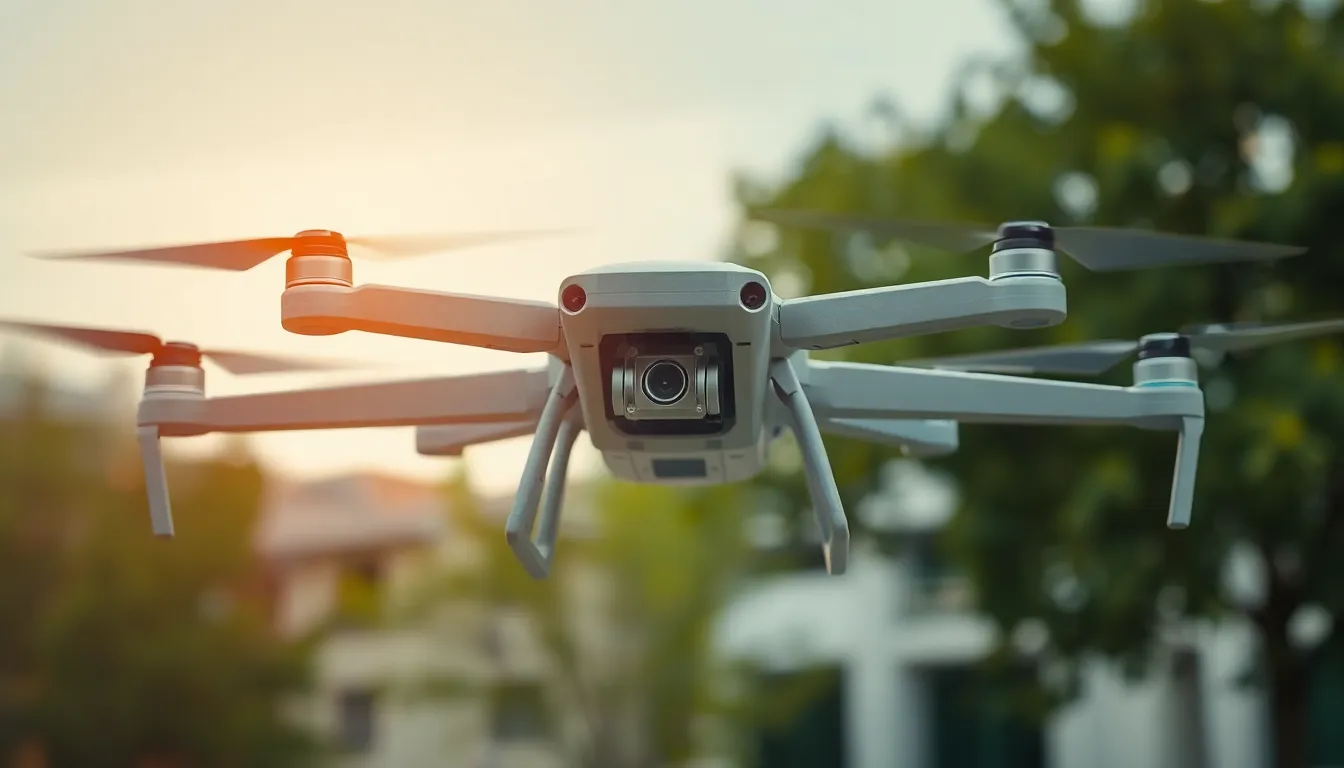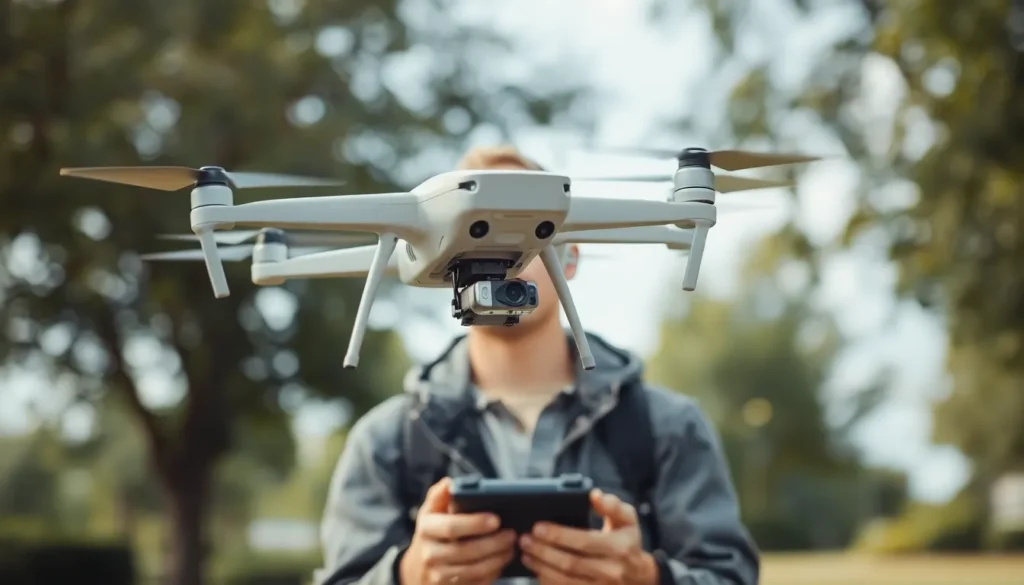In a world where drones zip through the skies like caffeinated bees, ensuring safety isn’t just a good idea—it’s essential. Picture this: a drone soaring high, capturing breathtaking views while you sip your coffee. Now imagine that same drone suddenly deciding to take a nosedive. Yikes! That’s where drone safety equipment swoops in to save the day.
Table of Contents
ToggleOverview of Drone Safety Equipment
Drone safety equipment plays a crucial role in preventing accidents and ensuring safe operation. Various types of equipment help mitigate risks associated with drone use.
First, collision avoidance systems assist in detecting obstacles and preventing mid-air collisions. These systems often use sensors to create a 3D map of the surrounding environment.
Next, GPS tracking devices enhance navigational accuracy. Real-time location tracking allows operators to monitor flights and recover drones in case of loss.
Moreover, fail-safe mechanisms provide added security during operation. These systems automatically land drones safely if they lose signal or experience low battery.
In addition, safety goggles ensure operators remain aware of their surroundings while controlling drones. Wearing goggles protects eyes from debris and enhances focus on the drone’s flight path.
Beyond personal safety, emergency parachutes can protect both the drone and people below. Parachutes deploy in critical situations, allowing drones to descend slowly instead of crashing.
Lastly, protective cases offer physical safety for drones during transport and storage. Cases minimize damage from impacts and environmental exposure, ensuring longer-lasting equipment.
Incorporating these components into a drone setup helps ensure smoother and safer flights.
Types of Drone Safety Equipment

Various types of drone safety equipment play vital roles in ensuring safe operations. Each component addresses specific risks associated with drone flights.
Collision Avoidance Systems
Collision avoidance systems utilize advanced sensors to detect obstacles in a drone’s path. These systems significantly reduce the likelihood of accidents by automatically adjusting the drone’s trajectory. Many models employ ultrasonic and infrared sensors for effective obstacle detection. Some systems even use camera-based technology for enhanced accuracy. Implementing collision avoidance systems increases situational awareness, ensuring safer flights in complex environments.
Parachute Recovery Systems
Parachute recovery systems provide a fail-safe mechanism during emergencies. When a drone encounters issues, such as loss of signal or critical battery levels, the parachute deploys automatically. This technology ensures a controlled descent, minimizing damage to the drone and protecting people and property below. Various manufacturers offer lightweight, compact designs that integrate seamlessly with most drones. Using parachute recovery systems enhances overall safety by adding an extra layer of security.
GPS and Tracking Devices
GPS and tracking devices enhance navigation accuracy and flight safety. These devices offer real-time positioning information, allowing operators to maintain control over their drones. Many tracking systems also enable flight path planning, facilitating seamless navigation during complex missions. Multiple options exist, from standalone GPS units to integrated systems within drones. Utilizing GPS and tracking devices significantly improves operational efficiency and ensures compliance with regulatory requirements.
Importance of Drone Safety Equipment
Safety equipment for drones plays a vital role in reducing potential hazards during operation. Understanding its importance contributes to safer flying experiences.
Protecting Lives and Property
Drone safety equipment is essential for safeguarding lives and property. Collision avoidance systems detect obstacles, preventing accidents that could harm individuals or damage vehicles. Automatic parachute systems minimize risks during emergencies by controlling descent, thereby protecting people below. Proper use of safety goggles enhances operator awareness, allowing for better decision-making while flying. Safe flying practices reinforce the protection of personal and commercial properties. Incorporating these devices not only ensures compliance with safety standards but also fosters confidence in drone usage.
Compliance with Regulations
Adhering to regulations is crucial for responsible drone operation. Many jurisdictions mandate specific safety equipment to comply with legal flight requirements. GPS tracking devices improve regulatory adherence by providing real-time location data, benefiting both operators and authorities. Implementing fail-safe mechanisms, like automatic landing systems during signal loss, fulfills safety mandates established by aviation administrations. Utilizing equipment that aligns with regulations demonstrates a commitment to safe practices and responsible airspace use. Compliance enhances operational efficiency while protecting operators from potential fines or penalties.
Selecting the Right Drone Safety Equipment
Choosing suitable drone safety equipment enhances operational safety. Various factors influence this choice, ensuring effective risk mitigation.
Factors to Consider
Safety equipment selection starts with compatibility. Operators should ensure equipment aligns with their specific drone models. Weight considerations matter too; extra equipment affects flight times and maneuverability. Regulatory compliance cannot be overlooked as jurisdictions mandate specific safety gear. The level of automation in systems, such as autopilot or manual controls, also affects choices. Assessing user experience helps identify intuitive interfaces for ease of use. Moreover, availability of support services plays a crucial role in long-term usability.
Recommended Brands and Products
Several brands excel in drone safety equipment. DJI offers notable collision avoidance systems widely used for various drone models. Parrot provides reliable GPS tracking devices that deliver real-time positioning. For emergency descent, Droneavi’s parachute recovery systems are effective due to their proven reliability. Fat Shark specializes in quality safety goggles that enhance operator situational awareness. When it comes to protective cases, GoProfessional Cases offers durable options that safeguard equipment during transport. Exploring these brands helps operators make informed decisions tailored to their operational needs.
Investing in drone safety equipment is essential for anyone operating drones today. The right tools not only enhance safety but also promote responsible flying practices. By utilizing advanced technologies like collision avoidance systems and GPS tracking devices operators can significantly reduce risks associated with drone flights.
Emergency equipment such as parachute recovery systems and safety goggles further protect both the operator and the public. Adhering to regulations and choosing compatible safety gear ensures compliance while improving overall flight experience.
Ultimately prioritizing safety equipment fosters confidence in drone operations and supports the growth of this innovative industry.

